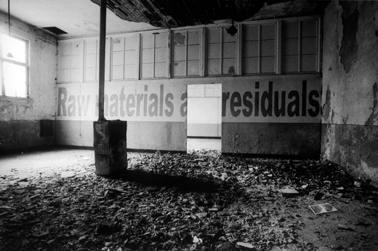raw materials and residuals
mauro sambo in trieste

On one side, water, on the other, jazz. In the middle, sculptures, videos and photos trace a personal journey inside the memory.
Mauro Sambo, a many-sided artist, and musician, proceeds through multiple artistic terms and individual experiences, exploring the possibility of an intimate fusion between art and life. For Sambo, art is a natural extension of existence, a rebellion against oblivion, where the aesthetic aspect is always subordinate to the conceptual aspect and the subjects confronted are tied to the same profound necessities. The central element of his work, the memory, filters the past through the wishes, illusions and restlessness of the present, virtually weaving the common destiny of mankind and places. The memory speaks through the details, the emotions of a life which has been lived or rebuilt, but also through that which remains, a residue of history, of ancient difficulties or of lost splendors.
Sambo loves to upset the line of time and proceed by superimpositions and dissonances; he controls and manipulates time, both accomplice and antagonist, just as he does with the images, in the effort of stopping or at least slowing the relentless flowing and all that is dragged along with it: estrangement, aging and oblivion.
Photography, emanation of past reality (as Roland Barthes would say), becomes a means for creating new atmospheres and putting memory into new context; not documentation, therefore, but the expression of an idea, of a state of being, a show of interior visions which have the sacredness of a ritual of purification.
In the series My father, my job, my life (2000), an homage to his father who died in 1974, the artist chooses and re-elaborates old images. The crumbling space of the Artiglierie dell’Arsenale becomes the context for reconstructing the memory of his father as a young man, just before he became prisoner of the English, and at the same time consecrate the memory of the place, capturing the countenance the moment of its mutation: passing states which are superimposed by a bond of affection and of identification which the artist sanctions and sublimes in fictitious installations.
The daily routine of the father, relived and stressed by the same motions, places and pathways, of remote rhythms and rituals dictated by water, is also the subject of a video of the same title, in which the identification takes on a disturbing and almost hypnotic course, suggesting a sense of struggle for survival and at the same time a need of shelter in one’s own certainties.
The recent videos Giudecca 347, The Long Hello and Settembre 2008, are also tied to affection and to familiar places, where the pain for the loss of the mother is transformed in a slow estrangement, both physical and mental or in simple and everyday cathartic moves.
Raw materials and residuals (2003), the other photographic series presented in exhibition, takes the title from an album of the saxophonist Julius Hemphill and is part of a wider circle dedicated to the mountains. The entire cycle originates from the chance discovery of some stereoscopic glass slides of the early 1900s with images of Monte Bianco, then re-elaborated, in some cases distorting the memory and in others just reducing them to a frame.
This time it’s the image of the mountain which is inserted in the abandoned and marvelous spaces of the Venetian Arsenale. In this unusual and comfortable venue it seems involved in a process of progressive disappearance, swallowed up by the ruins of history, of the fascination of a proud and dignified decline. The mountain, symbol of an admirable purity, uncontaminated and apparently immobile, is superimposed and compared to a culture of discarding, of trash, of fragment, to the residue of an inevitable change of the typically western infinite cycle of consumerism and of the renovation of things and ideas.
If in musical performance the beauty is entrusted to improvisation, in other works everything seems calibrated and measured. In the iron sculptures the artist works on the material in the hopes of impeding the natural process of oxidation; in the video he slows down the rhythm of the taping to the point of making movement imperceptible, in the photography he proceeds with minimal intervention and minimal oscillations of meaning.
The poetry of Sambo has a slow rhythm, it is revealed little by little through a constant dialogue between a descriptive/narrative pole and a spiritual/mystical one, playing with musical references and literary citations, retorts and suggestions in perfect balance between planning, instinct and chance.
If memory implicates a distance, distance implicates a journey and a journey implicates a search, it’s clear that Mauro Sambo’s work is a journey towards the discovery of one’s own identity, of one’s origins and the reasons for one’s own being. The private dimension opens itself to a universal perspective, in which even the most intimate movements become the expression of the most valuable aspects of the soul.
Without a solution of continuity, temporal and spatial distances intertwine to weave a new semantic level, and if for us the result is alienating, for the artist it’s a comforting sense of relief.
Laura Spolaore
in "Juliet Photo Magazine – Triestèfotografia", 2009
(English translation Liana Rotter)